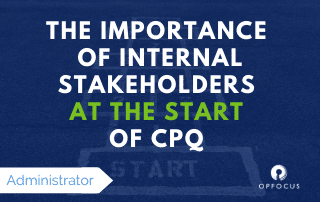Importance of Internal Stakeholders at Start of CPQ Projects

“How do we successfully kick off a CPQ project?” This is a great question but it can be a bit daunting to think about. A lot of detail goes into a successful Salesforce CPQ project. Having implemented dozens across various industries, we’ve learned what should happen at the start of a CPQ project to ensure things go well. Include all key stakeholders early.
Salesforce CPQ touches many different processes and departments within the company. For this reason, a successful project starts with identifying the key internal stakeholders. They will participate in implementing the goals and strategies of the project.
Stakeholders roles involve:
Communicating their department needs and signing off on requirements.
Providing business use cases.
Ensuring system functionality.
Driving user acceptance at deployment.
Stakeholders and functions include:
Project Manager – Oversees the project and keeps communication active between internal and external members. Ensures tasks are completed in a timely manner and decisions are made without delays.
Product/Pricing Expert: Expert with the existing product catalog. Understands product offering, product pairing options, product limits, and pricing of the product in terms of sale price. Also know when discounts should be applied and when the pricing can be overruled or needs approval and contract pricing.
Sales Users – This may be more than one person. Representatives from the Sales division that will provide an end-user, daily quote creation perspective on the system. This user would bring insight into how they see their customers asking for product mix, pricing variance experience, quote template presentation needs, and general ease of CPQ daily usage.
Finance/Accounting – This role is brought into the project to ensure key financial data and metrics, if required, are visible and being captured correctly. Information such as contract value, expansions, amendments, churns, etc. are captured using the same formulas finance/accounting uses on their reporting.
Marketing – Plays a role in the customer-facing document that will be created. Helping provide logos, and images in proper size/formats and are the most up to date versions. Ensures all needed information is captured on the document that is required.
IT – Sometimes you have other systems in your business you want to integrate with CPQ objects. Usual Integrations include Billing Systems, ERP System, or other legacy systems. IT will help ensure all integration processes are discussed throughout the project.
Identifying and involving these individuals at the start of a CPQ project will greatly improve the success of implementing a system that improves company efficiencies. Including them in decision-making and use case engagement will also avoid delays. When not involved, oftentimes these needs are identified late into the project.
The Consequence of Not Involving Stakeholders:
During a recent implementation, a company chose not to involve sales users in the building of their quote template being created in Salesforce CPQ. The customer project team we worked with was unaware of how much adjusting the sales team did when presenting data to customers. Depending on the customer needs and the sales user, the information was presented differently. For example, some users showed the discounts provided on the quote, others would hide them. This was the case for much of the content with little standardization around what information was displayed. Each sales user would create these by modifying a shared excel sheet.
Since the project team was unable to provide this information at the beginning, the Salesforce CPQ quote template was built with standard features based on the original excel sheet provided. While functional, it did not allow the type of customization the sales users needed on a quote to quote basis.
While Salesforce CPQ is easily adjusted and can provide this flexibility, not having the sales users present during its configuration caused frustration. The sales team was encumbered until updates were created, tested, adjusted, and approved within Salesforce CPQ.
This type of delay leads not just to frustration, but roadblocks in user acceptance. Although a correction to quote templates is quickly resolved, identifying and communicating with the correct stakeholders from the start can avoid this type of error.
Unidentified concerns:
As mentioned, when stakeholders aren’t actively involved in a project, not all business processes and needs are identified when initially building Salesforce CPQ. Therefore, user acceptance hits unnecessary roadblocks that can create frustration and delays in becoming fully functional.
These concerns typically relate to:
- User’s ability to adjust product pricing where needed.
- User’s ability to customize a product offering to fit a business need.
- Not identifying the approval Processes for key quotation reviews.
- Quote Templates not presenting all desired information in needed formats for particular offerings.
- Key financial calculations required for internal reporting are not present.
Involving all parties early on ensures everyone remains on the same page and all potential roadblocks are identified at the start.
So, while starting a Salesforce CPQ project can feel daunting, with the right preparation you can ensure it runs smoothly. Key stakeholders promote CPQ strategy and goals while providing important input, making the process much more effective. Not only will they kick off the project successfully but they can ensure it remains on track.
Final Thoughts
A successful Salesforce CPQ implementation leads to greater speed, greater efficiencies, and improved reporting. Additionally, it helps provide analytical decision-making in the Quote-to-Cash process of your business. For implementation to run smoothly, it’s important you identify your internal stakeholders from the start. You’ll need to convey the value of this platform to ensure everyone is fully bought in.
Your team may be thinking about a CPQ Implementation but doesn’t know where to start. Take a look at the impact this platform has had on teams just like yours to see if it’s the right fit. Once you’re ready, let’s connect and discuss how you can ensure a successful implementation that will best benefit your team.


